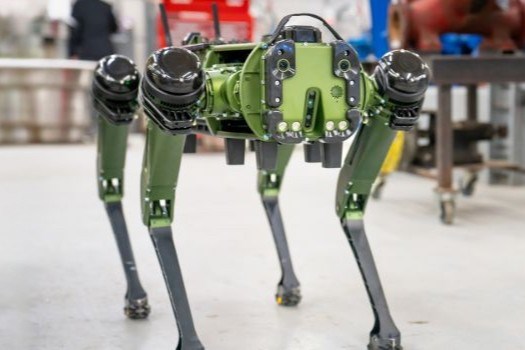MOOSE JAW — Post-secondary students and local businesses might soon witness the transformational power of cutting-edge technology, thanks to Saskatchewan Polytechnic’s latest acquisition: a quadruped robotic “dog” designed to tackle complex, critical tasks for applied research and fee-for-service projects.
Officially named Vision 60 Quadrupedal Unmanned Ground Vehicle (Q-UGV) and built by Ghost Robotics, this new robotic dog offers advanced capabilities including inspections at mine sites, surveillance, and mapping across difficult terrain. Plus, true to its canine appearance, the robot is fully capable of rolling over and fetching objects — with the help of a built-in robotic arm.
Situated at Sask. Polytech’s Digital Integration Centre of Excellence (DICE) in Saskatoon, the robot could prove invaluable for field testing in hazardous environments and will help local sectors explore digital solutions without significant upfront costs.
“The quadruped is an autonomous digital sensor/manipulator platform that allows DICE to assist with inspections and mapping, the initial stages of product development, and subsequent testing in a variety of unique situations and environments,” said Dr. Terry Peckham, the DICE director and research chair.
Dr. Peckham emphasized that the robot could play an important role in Saskatchewan’s digital landscape in fields such as agriculture, energy, and mining.
“The quadruped is a game-changer for businesses hesitant to invest in expensive digital platforms,” he said, adding that “Our quadruped will help Saskatchewan’s agriculture, mining, and potentially many other industries with digital transformation.”
The robot is equipped with a variety of sensors and radios on a relatively simple platform. This straightforward approach to the base design easily allows students to adapt to a wide range of research projects and different field applications.
“The quadruped is our eyes and ears on the ground. We will be able to view exactly what the quadruped detects through its mobile cameras and sensor platforms,” explained Kelvin Boechler, the DICE research manager.
Having access to the DICE quadruped will allow businesses to conduct proof-of-concept and field trials without the need to invest in unfamiliar — and costly — alternative technologies.
“For instance, it could be used by an agriculture company to test weed eradication using a heat source, demonstrating potential and identifying risks before investing in the technology for themselves,” Boechler added.
According to Boechler, the quadruped can work in tandem with Unmanned Aerial Vehicles (UAVs), autonomous vehicles, and digital sensors, and includes the ability to operate in GPS-denied or limited environments such as underground mines, tunnels, and building interiors.
DICE’s innovative projects with the quadruped robot offers students and recent graduates the unique opportunity to apply their knowledge in real-world settings, thereby allowing them to gain practical experience using advanced technology.
Partner organizations also benefit from DICE’s exceptional resources that include high-performance computational facilities, faculty expertise, student researchers, and — importantly — access to research funding.
“The initial cost of digital platforms and tools like the quadruped can be an impediment to organizations,” Dr. Peckham said. “That is where DICE comes in — we have the tools, expertise, and experience to help businesses with their digital challenges.”
As Saskatchewan’s first Technology Access Centre (TAC), supported by the Natural Sciences and Engineering Research Council of Canada (NSERC) and Innovation Saskatchewan, DICE specializes in applied research related to data analysis, storage, and display — positioning itself as a valuable hub for collaboration and innovation in the province.
For more information visit SaskPolytech.ca/DICE.




